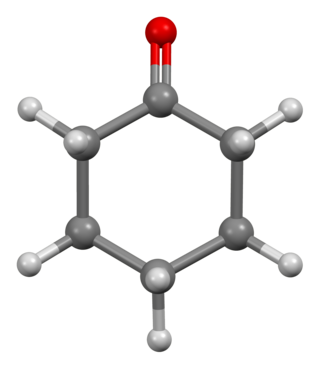
In organic chemistry, an alkene is a hydrocarbon containing a carbon–carbon double bond. The double bond may be internal or in the terminal position. Terminal alkenes are also known as α-olefins.

Petrochemicals are the chemical products obtained from petroleum by refining. Some chemical compounds made from petroleum are also obtained from other fossil fuels, such as coal or natural gas, or renewable sources such as maize, palm fruit or sugar cane.

1,3-Butadiene is the organic compound with the formula CH2=CH-CH=CH2. It is a colorless gas that is easily condensed to a liquid. It is important industrially as a precursor to synthetic rubber. The molecule can be viewed as the union of two vinyl groups. It is the simplest conjugated diene.
A diol is a chemical compound containing two hydroxyl groups. An aliphatic diol is also called a glycol. This pairing of functional groups is pervasive, and many subcategories have been identified.
In chemistry, a trimer is a molecule or polyatomic anion formed by combination or association of three molecules or ions of the same substance. In technical jargon, a trimer is a kind of oligomer derived from three identical precursors often in competition with polymerization.

Cyclohexanone is the organic compound with the formula (CH2)5CO. The molecule consists of six-carbon cyclic molecule with a ketone functional group. This colorless oily liquid has a sweet odor reminiscent of benzaldehyde. Over time, samples of cyclohexanone assume a pale yellow color. Cyclohexanone is slightly soluble in water and miscible with common organic solvents. Billions of kilograms are produced annually, mainly as a precursor to nylon.
In organic chemistry, the Knoevenagel condensation reaction is a type of chemical reaction named after German chemist Emil Knoevenagel. It is a modification of the aldol condensation.

Polybutadiene [butadiene rubber BR] is a synthetic rubber. Polybutadiene rubber is a polymer formed from the polymerization of the monomer 1,3-butadiene. Polybutadiene has a high resistance to wear and is used especially in the manufacture of tires, which consumes about 70% of the production. Another 25% is used as an additive to improve the toughness of plastics such as polystyrene and acrylonitrile butadiene styrene (ABS). Polybutadiene rubber accounted for about a quarter of total global consumption of synthetic rubbers in 2012. It is also used to manufacture golf balls, various elastic objects and to coat or encapsulate electronic assemblies, offering high electrical resistivity. Polybutadiene is typically crosslinked with sulphur, however, it has also been shown that it can be UV cured when bis-benzophenone additives are incorporated into the formulation.
Cycloocta-1,5-diene is a cyclic hydrocarbon with the chemical formula C8H12, specifically [−(CH2)2−CH=CH−]2.

Evonik Industries AG is a publicly-listed German specialty chemicals company headquartered in Essen, North Rhine-Westphalia, Germany. It is the second-largest chemicals company in Germany, and one of the largest specialty chemicals companies in the world. It is predominantly owned by the RAG Foundation and was founded on 12 September 2007 as a result of restructuring of the mining and technology group RAG AG.
Heptanal or heptanaldehyde is an alkyl aldehyde. It is a colourless liquid with a strong fruity odor, which is used as precursor to components in perfumes and lubricants.

4-Vinylcyclohexene is an organic compound consisting of a vinyl group attached to the 4-position of the cyclohexene ring. It is a colorless liquid. Although chiral, it is used mainly as the racemate. It is a precursor to vinylcyclohexene dioxide.

Cyclododecane is an organic compound with the chemical formula (CH2)12. It is a waxy white solid at room temperature, and is soluble in nonpolar organic solvents.

Dichlorotris(triphenylphosphine)ruthenium(II) is a coordination complex of ruthenium. It is a chocolate brown solid that is soluble in organic solvents such as benzene. The compound is used as a precursor to other complexes including those used in homogeneous catalysis.

Cholesterol total synthesis in chemistry describes the total synthesis of the complex biomolecule cholesterol and is considered a great scientific achievement. The research group of Robert Robinson with John Cornforth published their synthesis in 1951 and that of Robert Burns Woodward with Franz Sondheimer in 1952. Both groups competed for the first publication since 1950 with Robinson having started in 1932 and Woodward in 1949. According to historian Greg Mulheirn the Robinson effort was hampered by his micromanagement style of leadership and the Woodward effort was greatly facilitated by his good relationships with chemical industry. Around 1949 steroids like cortisone were produced from natural resources but expensive. Chemical companies Merck & Co. and Monsanto saw commercial opportunities for steroid synthesis and not only funded Woodward but also provided him with large quantities of certain chemical intermediates from pilot plants. Hard work also helped the Woodward effort: one of the intermediate compounds was named Christmasterone as it was synthesized on Christmas Day 1950 by Sondheimer.

Cyclohexanedimethanol (CHDM) is a mixture of isomeric organic compounds with formula C6H10(CH2OH)2. It is a colorless low-melting solid used in the production of polyester resins. Commercial samples consist of a mixture of cis and trans isomers. It is a di-substituted derivative of cyclohexane and is classified as a diol, meaning that it has two OH functional groups. Commercial CHDM typically has a cis/trans ratio of 30:70.

Laurolactam is an organic compound from the group of macrocyclic lactams. Laurolactam is mainly used as a monomer in engineering plastics, such as nylon-12 and copolyamides.
4,4'-Diaminodicyclohexylmethane is the name for organic compounds with the formula CH2(C6H10NH2)2. It is classified as a diamine. In the epoxy industry it is often referred to as PACM, short for para-diaminodicyclohexylmethane. It is used as a curing agent for epoxy resins It finds particular use in epoxy flooring. Another use is to produce diisocyanates, which are precursors to polyurethanes. The mixture is a colorless solid, but typical samples are yellowish and oily. The compound is produced as a mixture of three isomers by the hydrogenation of methylenedianiline. These isomers are, in decreasing order of their yield from the hydrogenation, trans-trans, cis-trans, and a small amount of cis-cis.

Marl Chemical Park is an industrial park in Marl, North Rhine-Westphalia, Germany. It is the third largest industrial cluster in Germany and among the largest chemical production facilities in Europe. The site occupies over 6 square kilometers, hosts 100 chemical plants, employs 10,000 people, and produces 4 million metric tons of chemicals annually. 18 companies are based in the Park, including primary tenant Evonik Industries AG, which also owns and operates the infrastructure through its subsidiary Infracor GmbH.

trans,trans,trans-(1,5,9-Cyclododecatriene)nickel(0) a organonickel compound with the formula NiC12H18, better known as t-Ni(cdt). It is a 16-electron coordination complex featuring trigonal planar nickel(0) bound to the three alkene groups in the cyclododecatriene ligand. X-ray structural analysis demonstrates that the three olefins adopt a propeller-like arrangement around the nickel atom center, making the structure chiral. This extremely air-sensitive deep red solid was the first discovered Ni(0)-olefin complex.


















